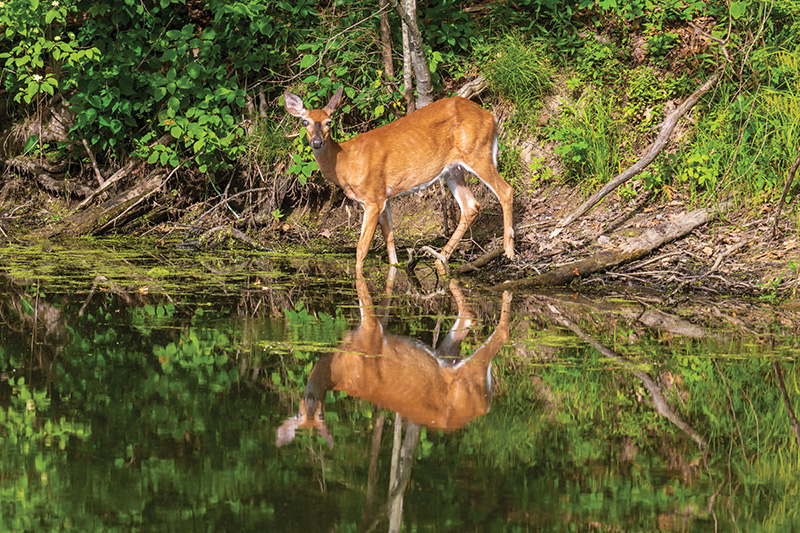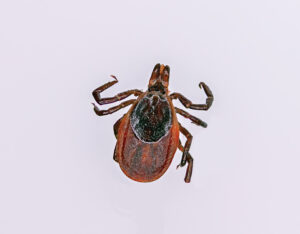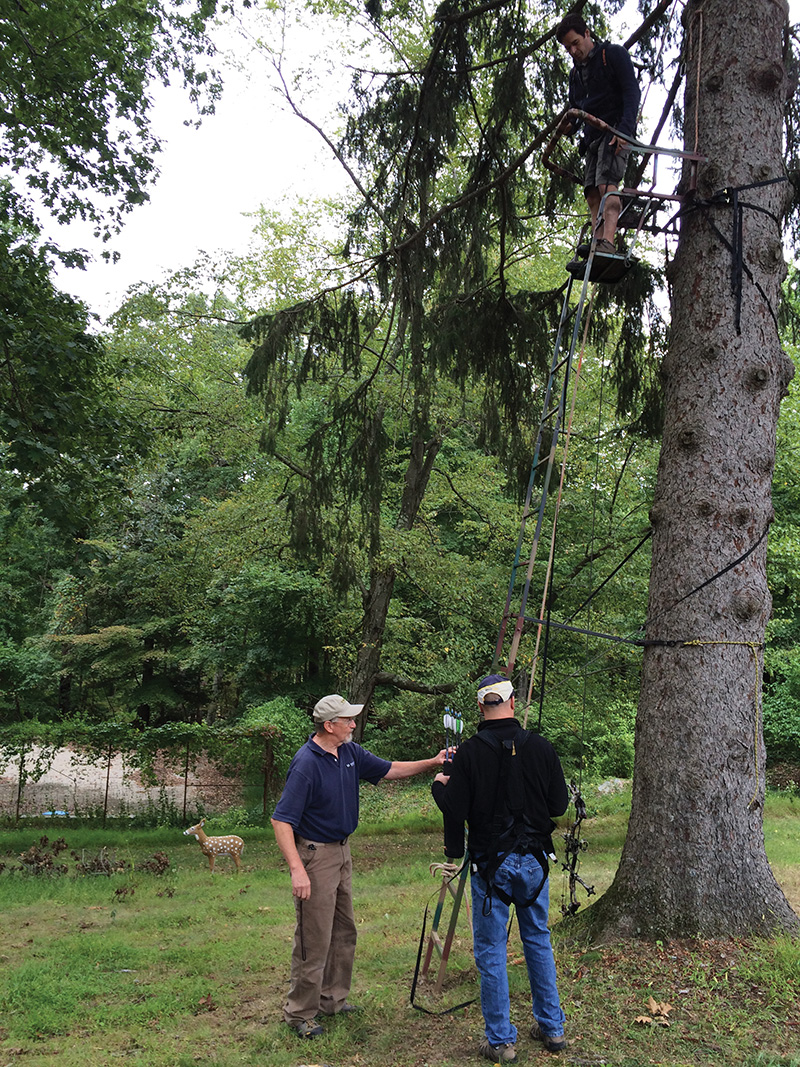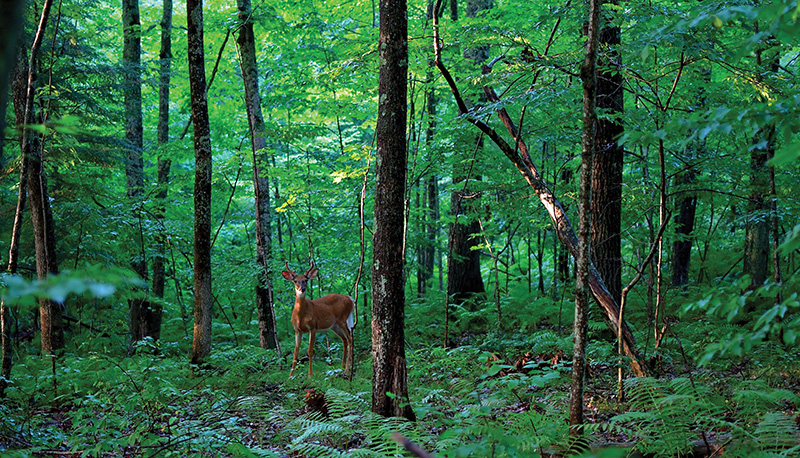
A female white tailed deer is reflected in water in Windsor Locks, Connecticut. Image Credit: Getty Images/Jennifer Yakey-Ault
The
Most
Dangerous Animal
in
America
Connecticut is at the infestation epicenter of a beast that kills some 200 Americans a year; injures at least 10,000 others; is annually responsible for billions of dollars in property damage; trashes native ecosystems; and spreads an infection that causes fever, headache, fatigue, and, if untreated, injury to joints, heart, and brain.
The beast is the white-tailed deer, rare during the 19th century and now, with forest regeneration and no obligate predators, grossly overpopulated. Hunters can’t significantly affect deer densities. Bobcats—especially in Connecticut where they’re proliferating—and coyotes provide some relief, but not control. East of the Lake States the predators that can control deer—wolves and cougars—have been extirpated.

A deer tick, otherwise known as the black-legged tick. Image Credit: Getty Images/Forest Swaciak
The infection is Lyme disease (so named because it was discovered in Lyme, Connecticut). It’s transmitted by blacklegged ticks, a.k.a. “deer ticks.” Each year the Centers for Disease Control and Prevention (CDC) confirms about 30,000 cases, but it estimates that something like 270,000 other cases go unreported.
In addition to deaths and injuries from vehicle collisions with deer, the National Highway Traffic Safety Administration assesses annual vehicle damage at roughly $1 billion. That’s a tiny fraction of dollar damage to forests, gardens, and ornamental plants.
Ground nesting birds like wild turkeys, ruffed grouse, woodcock, ovenbirds, and whippoorwills suffer most. And a 10-year study by the US Forest Service reveals that, at more than 20 deer per square mile, there’s complete loss of cerulean warblers, yellow-billed cuckoos, indigo buntings, eastern wood pewees, and least flycatchers. At 38 deer per square mile, eastern phoebes and even robins disappear.
Connecticut deer densities vary according to habitat type, but the statewide average is around 40 per square mile. Here and in most eastern states, deer are nuking wildlife habitat, including their own. In the words of former Pennsylvania deer manager Dr. Gary Alt, allowing this to happen [the deer population to grow] is “the biggest mistake in the history of wildlife management.”
The only proven way to reduce the deer population is culling by experienced, trained sharpshooters.
![]()
Years ago I visited a farm in Connecticut the trees of which, to the casual observer, looked beautiful. A lush carpet of ferns and Japanese barberry stretched toward the Connecticut River. No understory obstructed the view through the canopied woods.
It could scarcely look uglier, however, to the two wildlife biologists who accompanied me—Drs. Tony DeNicola of White Buffalo Inc. and Scott Williams of the Connecticut Agricultural (Ag) Experiment Station.
White Buffalo, a nonprofit that DeNicola co-founded in 1995, protects and restores native wildlife all over the world by culling overpopulated invasive species—everything from native white-tailed-, black-, and mule deer to aliens like axis and fallow deer, feral hogs, and macaque monkeys. Williams researches strategies for abating ticks and associated pathogens.

White Buffalo proficiency testing for archery culling, Teatown, NY. Image Credit: Tony DeNicola
“The earth curves,” Williams told me, “and you can still see barberry on the horizon.” That’s because deer didn’t evolve with barberry and find it unpalatable. The abundant ferns, though native, are there because deer avoid them, too.
Barberry provides a humid microclimate and predator cover for rodents, especially white-footed mice—principal reservoir hosts that infect deer ticks with the Lyme disease bacteria. About 80 percent of the ticks that Williams and his team collect from the Connecticut farm carry the bacteria. Limit barberry, and you limit Lyme disease!
So from 2007 to 2017 the Ag Station experimented with barberry suppression here and on other study sites, blasting it with flame throwers. “We determined that every five years you need to re-manage because barberry and ticks come back,” says Williams. That research is proving valuable for homeowners, land trusts, and sanctuaries.
![]()
Many state resource agencies claiming to be “stewards of the landscape” are really stewards of hunting-license sales. DeNicola and Williams cite the Connecticut Department of Energy and Environmental Protection as a positive exception. It tries to do the right thing, but communities hamstring it.
In Redding, Connecticut, Williams and DeNicola initiated an experiment funded by the Center for Disease Control to see if balancing deer with habitat could break the Lyme disease cycle. In two one-square-mile study plots they planned to reduce overpopulated, tick-riddled deer to a healthy and natural 8 to 10 animals per square mile and document tick and pathogen abundance.
But hunters calling themselves the Redding Sportsmen’s Alliance whipped the community and politicians to a froth of panic and paranoia over imagined reduction in hunting opportunity. They accused White Buffalo of “breaking state and federal laws” by using .223 caliber rifles and silencers, shooting at night, and killing deer without hunting licenses—all this despite the fact that White Buffalo held all the necessary permits for their culling practices.

White-tailed doe and yearling in New England woods. Images Credit: Getty Images/Robert Winkler.
After the Ag Station counted 45 deer per square mile on the study plots from a helicopter flying 20 mph at 200 feet, Alliance members dismissed the figure as “mathematically impossible” because they’d observed only 2 deer per square mile—from a Cessna flying 120 mph at 500 feet. “One member,” Williams says, “put on night-vision goggles and body armor and sat next to the shooting site to ‘keep an eye on White Buffalo.’ Another was following us around, videotaping. Someone was going to get hurt, so I pulled the plug.” Although White Buffalo had removed 87 deer over 3 years, that didn’t reduce the population to anywhere near target. So all the effort and grant money was wasted.
The debacle taught the Ag Station an important lesson—that tick suppression by deer reduction can’t work because it’s a political tinder box.
So now, to reduce ticks on deer, the Ag Station and White Buffalo are experimenting with corn treated with an Ivermectin derivative called Moxidectin, basically the stuff administered to dogs and cats to kill ticks and fleas. “Twenty years ago Texas and Maine experimented with a similar formulation, and it worked well,” Williams says. “But […] people couldn’t eat the venison for 48 days after deer ingested it. That precluded application.”
With Moxidectin, however, venison can be safely consumed immediately. Williams has applied for a five-year, $5 million CDC grant to treat entire towns if the current experiment succeeds.
Preliminary results are encouraging. On two research sites the Ag Station has contracted White Buffalo to tranquilize deer, count ticks, and draw blood to see if it contains sufficient Moxidectin. This from DeNicola: “It looks like we’re getting beyond the threshold that will eliminate ticks. We need to put out more bait. A couple deer eat two pounds each. Then, after blackbirds, turkeys, and dominant bucks come in, there might not be enough for subordinate deer. I think we’ll make those adjustments this year.”
![]()
There are plenty of informed naturalists who hunt. But, as in Redding, there are also plenty of loud, ecologically-challenged hunters who proclaim that they can control deer and who are also politically connected. No one has more experience with these types and the bureaucrats they intimidate than DeNicola. He offers the examples of Iowa City, Iowa, and Princeton, New Jersey.
In 1999, Iowa City contracted White Buffalo to cull deer that were overrunning neighborhoods. That winter, using tree stands, bait, and night-vision gear, White Buffalo culled 360 deer, as always killing them instantly with head shots, wounding none. In 2009 White Buffalo knocked down the population to the point that there was no reason for it to return until 2011.
“In that interim all the politicians left and everybody in law enforcement left,” says DeNicola. “There was next to no institutional memory. We heard nothing until 2017. Then I get a call, and it’s Groundhog’s Day—like I’d never set foot in Iowa. ‘They’re eating all our plants,’ they told me. ‘We’re hitting them on roads.’ I had to go through everything all over again. The state Department of Natural Resources [DNR] gave us that one year, then told us it would use hunters. I told DNR that no way in hell could hunters maintain densities. Just to keep the population stable they’d have to kill 55. Three of us went out in the winter of 2019–20 and killed 500 deer. In fall 2020 hunters killed three; last fall four. Twenty-three years later, and DNR is still torturing people in an effort to prove that hunting is a solution. It hurts my head.”

Young male white-tailed deer in Connecticut woods.
When White Buffalo started culling at Princeton in 2001 there were 342 deer-vehicle collisions a year, the highest DeNicola has ever seen. Deer were crashing through picture windows, landing on laps, thrashing, and gushing blood.
But any intentional killing was anathema to the animal-rights community. It unsuccessfully sued White Buffalo five times, unsuccessfully attempted to draw deer away from White Buffalo bait sites by spreading corn, contaminated bait sites with ammonia, punctured White Buffalo truck tires, paraded with placards, held candlelight vigils, offered each of 24 landowners $2,000 to kick DeNicola and his team off their deer-denuded property. None accepted.
Today, animal-rights activists, some of whom have been infected with Lyme disease, generally have no problem with deer culling. These days virtually all opposition comes from hunters.
Even in Princeton hunters still claim they can create and maintain natural deer densities. “Early on they’d kill maybe 60 or 70, and we’d come and kill 200,” says DeNicola. “In 2021 with a four-month season with bait and no limit they killed 33. We went in with three guys, and killed 147 in two and a half weeks.”
Ted Williams writes exclusively about fish and wildlife for national publications. He takes some credit for the important work of Dr. Scott Williams, who is his son.

